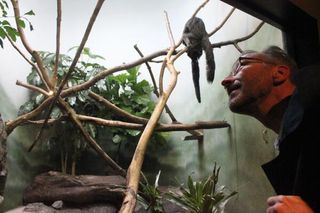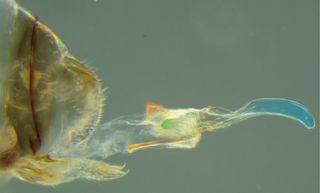How Corkscrew Vaginas and Female Penises Evolved

BROOKLYN, N.Y. — A male ruddy duck with a sky-blue beak coasted across a pond here at the Prospect Park Zoo, brightening a rudely cold spring day.
"There's a very nice sexually selected bill color," Dutch biologist Menno Schilthuizen said, poking his head over the wooden-post fence.
At some point in the species' history, female ruddy ducks decided blue bills were sexy, and evolution favored the flamboyant feature. But evolution just as carefully selected another extravagant male trait, which, at the time, was hidden: a long, corkscrew-shaped penis. [The 7 Weirdest Animal Penises]
In his new book, "Nature's Nether Regions" (Viking, 2014), Schilthuizen takes a sweeping look across the animal kingdom — from ducks to hermaphroditic snails that have sex all day to sharks that use one of their penises, or "claspers," (they have two) to flush rival sperm out of the female's vagina — to illustrate an amazing diversity of genitalia that has been largely unappreciated, even among scientists.
A sluggish start
"I think a lot of evolutionary biologists and people working on sexual selection were not fully aware of the genital diversity that exists," Schilthuizen told Live Science in an interview at the zoo, commenting on the study of the evolution of sex parts, which has only taken off in the last 25 to 30 years. "The information was there, but it was contained within the field of taxonomy, where it was used extensively for identifying and circumscribing species."
Many bumblebee species, for example, share the same wardrobe, and the only way for taxonomists to tell them apart was to capture a male and examine its penis, Schilthuizen explained in his book. But it took decades for scientists to realize that species-specific sex parts weren't part of some lock-and-key design, but rather something more complex.
Sign up for the Live Science daily newsletter now
Get the world’s most fascinating discoveries delivered straight to your inbox.
Back to the ruddy duck: While most birds don't have any penis whatsoever, ducks do, and these prodigious members unfurl explosively when it's time to mate. Only recently did scientists discover that some female ducks have long, corkscrew-shaped vaginas that spiral in the opposite direction as the male's member. This allows the female to fight back against undesirable, notoriously aggressive males, since the duck's penis won't fit so easily. In this way, duck genitals look less like the byproducts of choosy females than the consequences of a sexual arms race, where male and female parts have evolved in response to each other's ever-advancing equipment.
Charles Darwin might bear some of the blame for this tunnel vision. For all his contributions to the study of evolution, Darwin's focus on secondary features unconnected to sex organs may have limited how biologists began investigating sexual selection.
"Because Darwin had paved the way with colorful feathers, rather than genitals, people who work on sexual selection had immediately started working on bird plumage and external features of precopulatory sexual selection, things like these colorful furs," Schilthuizen said, this time pointing at the orange coats of the perky marmosets hopping between branches behind the glass of an indoor display. And sexual selection of bright colors and bizarre nether regions are not simply special cases of natural selection. [Why So Many Animals Evolved to Masturbate]
"It's really sort of like chasing a moving target," Schilthuizen said. "It's not a kind of evolution that has an optimum or an end point, which adaptation to the environment often does have. The environment is usually much more static than the other half of the same species that co-evolves in response. That's, by definition, a very dynamic kind of evolution."
Female penises, male vaginas
When talking about genitals, scientists risk wading into a "semantic morass," as Schilthuizen calls it in his book. That was perhaps apparent in April when a group of researchers announced the discovery of four news species of cave insects in which the females have a penis — or technically, an organ called a "gynosome," which acts like a penis — and the male organ more closely resembles a vagina with valuable packets of sperm.

"It's such a good way of illustrating that sexual roles are not about what sex chromosomes you have or what kind of sex cells you produce, but it's really about how much you invest in the offspring, and that is what drives not only the intensity but also the direction of sexual selection," Schilthuizen said.
For the role-reversing cave insects of the genus Neotrogla, the males' sperm packets, or spermatophores, offer hard-to-come-by nutrients to the females to produce eggs and nourish their offspring. [See Photos of the Genital-Reversed Cave Insects]
"The male has become the sex which invests most nutrients in the offspring, so the male has become the choosy sex, and the females compete over access to the males with their large nutrient spermatophore," Schilthuizen said. "That has set in motion the evolution of an intermittent organ in the females to either forcefully or otherwise persuade the male to give up that spermatophore."
Human bias
Perhaps our tendency to anthropomorphize even tiny cave insects makes Neotrogla's gender-reversed arrangement seem bizarre. But if human bias distorts the way we look at animals, it also distorts the way we view ourselves.
As recently as the 1960s, many people — biologists even — held on to the rather romantic notion that the female orgasm was unique to humans and perhaps functioned as a way to promote bonding between couples. But for many animals, courtship extends beyond flaunting a flashy coat. Most female mammals have a clitoris, and likely experience orgasms during sex, though the organ might take on a shape wildly different from the human variety. Female spotted hyenas, for example, give birth through their 7-inch-long (18 centimeters) clitoris that looks more like a pseudopenis.
So what sets humans apart? Human males don't have spines on their penises as chimpanzees (humans' closest living relatives) and other large primates do, and females don't experience conspicuous swelling of the vagina when they are fertile and ready to mate, Schilthuizen said, giving two examples. But one could revert the argument and find features on any animal that make it special.
"When everything is bizarre, then nothing is bizarre," Schilthuizen said. "We have a tendency to still use what is familiar as the norm, and we need to realize that very few animals, because of this diversity, can be directly compared to humans or other animals that we are familiar with. And at a certain point, I wouldn't say you become blasé, but you become aware that this unpredictably is more characteristic of sexual evolution than anything else. When you realize this, you stop being surprised."
At the same time, with more knowledge about the multitude of intimate arrangements in the animal world, the most mundane creatures seem more fascinating.
"Even the chipmunks and squirrels that you see in the park here — once you know that they have sperm plugs and asymmetric penises and things like that, you look at them in a very different way," Schilthuizen said.
Follow Megan Gannon on Twitter and Google+. Follow us @livescience, Facebook & Google+. Original article on Live Science.

Most Popular




